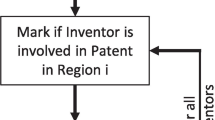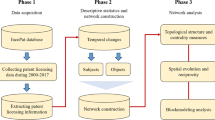Abstract
The object is to identify the flux of information and get to know the socio-spatial and socioinstitutional dimensions of knowledge in the process of innovation, and to be able to visualize the impact and cognitive relationships of the sources of information used in the production of patents, as well as interactions and social cooperation that exists between the local innovative agents of The State University of Campinas. The research is of an exploratory nature with a case study design, in order to find out, by means of patentometric indicators, the flow and social relations characterized by cognitive and institutional aspects of local and regional knowledge based on the production of the Institution’s patents.
Similar content being viewed by others
References
C. Lemos, Inovação na era do conhecimento. In: H. M. M Lastres, S. Albagli, Informação e globalização na era do conhecimento. Rio de Janeiro, Campus, 1999. p.122–144.
R. Mansell, U. When, Innovation systems and the learning process: how people in firms are learning to organize and manage ICT and related services. In: Knowledge Societies: Information Technology for Sustainable Development. New York, Oxford University Press, 1998. pp. 46–62.
C. Freeman, La economia de la innovacion industrial. Alianza Editorial, Madrid, 1975.
H. Etzkowitz, L. Leydesdorff, The dynamics of innovation: from national systems and “mode 2” to a triple helix of university-industry-government relations. Research Policy, 29 (2000) 109–123.
M. Gibbons, New Production of Knowledge: Dynamics of Science and Research in Contemporary Societies. London, Sage Publications, 2000, p. 179.
H. M. M. Lastres, Indicadores da era do conhecimento: pautando novas políticas na América Latina. Sexto Taller de Indicadores de Ciencia y Tecnología Iberoamericano e Interamericano: medir el conocimiento para la transformación social. Buenos Aires, 15 a 17 de setembro, 2004.
B. A. Lundvall, Políticas de inovação na economia do aprendizado. Parcerias Estratégicas, n. 10, pp. 200–218, mar. 2001.
S. Albagli, M. L. Maciel, Informação e conhecimento na inovação e no desenvolvimento local. Ciência da Informação, Brasília, 33 (2004) 9–16. Disponível em: http://www.ibict.br /cienciadainformacao/viewarticle.php?id=638&layout=abstract. Acesso em: 24 out. 2007.
G. Sirilli, El desarrolo de indicadores de ciencia y tecnologia en la OCDE: la red NESTI. In: M. Albornoz, C. Alfaraz, Redes de conocimiento: construcción, dinámica y gestión. Argentina: Red Iberoamericana de Indicadores de Ciencia y Tecnología (RICYT), 2006. pp. 113–130.
H. M. M Lastres, L. R. I. Legey, S. Albagli, Indicadores da economia e sociedade da informação, conhecimento e aprendizado. In: E. B. Viotti, M. M. Macedo. (Org.). Indicadores de ciência, tecnologia e inovação no Brasil. Campinas, Editora da Unicamp, 2003.
Organization for Economic Co-Operation and Development — OECD. The measurement of scientific and technological activities: proposed standard practice for surveys on research and experimental development — Frascati Manual. Paris, OECD, 2002, p. 254.
Organization for Economic Co-Operation and Development — OECD. The measurement of scientific and technological activities: proposed standard method of compiling and interpreting technology balance of payments data — TBP Manual. Paris, OECD, 1998, p. 84.
Organization for Economic Co-Operation and Development — OECD. Mensuração das atividades científicas e tecnológicas: proposta de diretrizes para coleta e interpretação de dados sobre inovação tecnológica — Manual de Oslo. Paris, OECD, 2005, p. 136.
Organization for Economic Co-Operation and Development — OECD. The measurement of scientific and technological activities: using patent data as science and technology indicators — Patent Manual. Paris, OECD, 1994, p. 108.
Organization For Economic Co-operation And Development — OECD. The measurement of scientific and technological activities: manual on the measurement of human resources devoted to S&T — Canberra Manual. Paris, OECD, 1995, p. 111.
E. Assunção, Universidades brasileiras e patentes: utilização do sistema nos anos 90. Instituto Nacional da Propriedade Industrial — INPI. Série: Estratégias nacionais de patenteamento. 2000. Disponível em: http://www.geocities.com/prop_industrial/univ_pdf., Acesso em: 5 jun. 2006.
J. S. Nunes, L. G. Oliveira, Universidades brasileiras: utilização do sistema de patentes de 2000 a 2004. Rio de Janeiro, INPI, 2007.
E. M. Albuquerque, Patentes e atividades inovativas: uma avaliação preliminar do caso brasileiro. In: E. B. Viotti, M. M. Macedo (Org.). Indicadores de ciência, tecnologia e inovação no Brasil. Campinas, Editora da UNICAMP, 2003, pp. 329–376.
Guzman Sanchez, M. V., Patentometria: herramienta para el análisis de oportunidades tecnológicas. 130f. Tesis (Doutorado em Gerência de Información Tecnológica) — Facultad de Economia, Universidad de La Habana, Cuba, 1999.
E. Spinak, Indicadores cienciométricos de patentes: aplicaciones y limitaciones. Madrid: [s.n.], mar. 2003. Disponible en: http://www.ricyt.org/interior/normalizacion/III_bib/Spinak.pdf, Acceso en: 20 Jun. 2007.
F. Narin, D. Olivastro, Status report: linkage between technology and science. Research Policy, 21 (1992) 237–249.
F. Narin, Patents bibliometrics. Scientometrics, 30 (1994) 147–155.
F. Narin, Patents as indicators for the evaluation of industrial research output. Scientometrics, 34 (1995) 489–496.
M. Callon, J. P. Courtial, H. Penan, Cienciometria: el estudio cuantitativo de la actividad científica. Oviedo: TREA, 1995.
U. Schmoch, Indicators and the relations between science and technology. Scientometrics, 38 (1997) 103–116.
M. Meyer, What is special about patent citations? Differences between scientific and patent citations. Scientometrics, 49 (2000) 93–123.
Author information
Authors and Affiliations
Corresponding author
Rights and permissions
About this article
Cite this article
Pereira, C.A., Bazi, R.E.R. Flow and social relationships of knowledge in science, technology and innovation: A patentometric study of UNICAMP’s technological production. Scientometrics 81, 61–72 (2009). https://doi.org/10.1007/s11192-009-2096-1
Received:
Published:
Issue Date:
DOI: https://doi.org/10.1007/s11192-009-2096-1




